Page 45 of 315
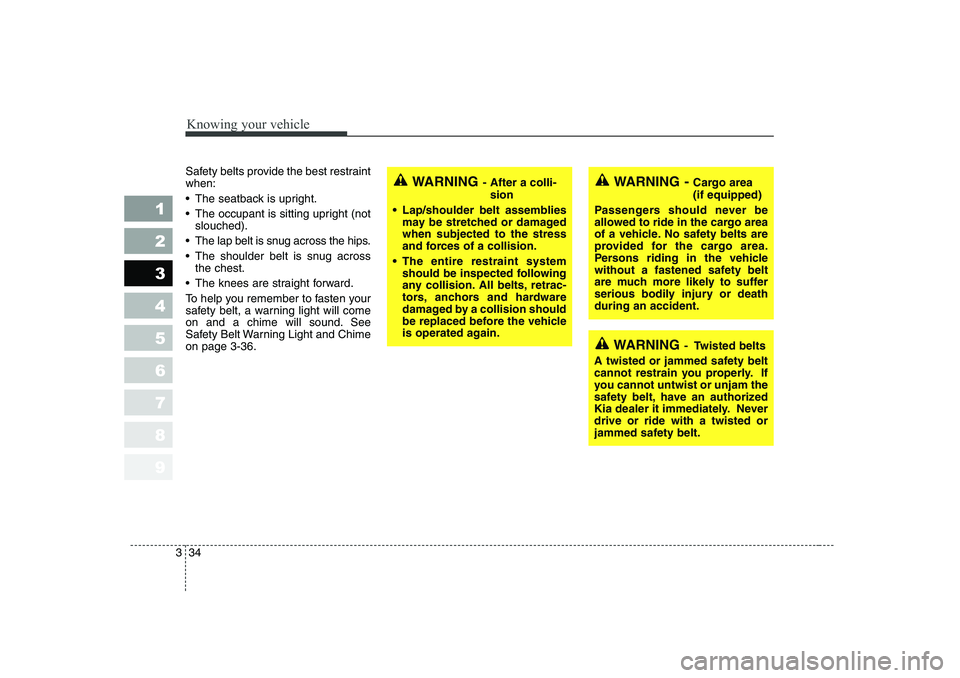
Knowing your vehicle
34
3
1 23456789
Safety belts provide the best restraint when:
The seatback is upright.
The occupant is sitting upright (not
slouched).
The lap belt is snug across the hips.
The shoulder belt is snug across the chest.
The knees are straight forward.
To help you remember to fasten your
safety belt, a warning light will come
on and a chime will sound. See
Safety Belt Warning Light and Chimeon page 3-36.WARNING - After a colli-
sion
Lap/shoulder belt assemblies may be stretched or damaged when subjected to the stress
and forces of a collision.
The entire restraint system should be inspected following
any collision. All belts, retrac-
tors, anchors and hardware
damaged by a collision should
be replaced before the vehicle
is operated again.WARNING - Cargo area (if equipped)
Passengers should never be
allowed to ride in the cargo area
of a vehicle. No safety belts are
provided for the cargo area.
Persons riding in the vehicle
without a fastened safety belt
are much more likely to suffer
serious bodily injury or deathduring an accident.
WARNING - Twisted belts
A twisted or jammed safety belt
cannot restrain you properly. If
you cannot untwist or unjam the
safety belt, have an authorized
Kia dealer it immediately. Neverdrive or ride with a twisted or
jammed safety belt.
Page 46 of 315
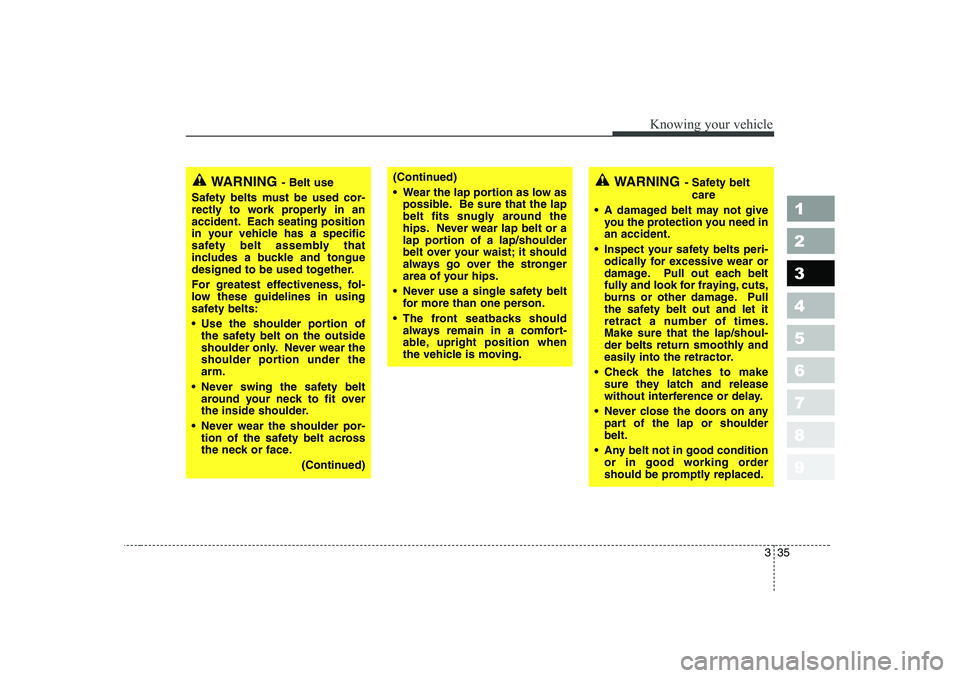
335
1 23456789
Knowing your vehicle
WARNING- Belt use
Safety belts must be used cor-
rectly to work properly in an
accident. Each seating position
in your vehicle has a specific
safety belt assembly that
includes a buckle and tongue
designed to be used together.
For greatest effectiveness, fol-
low these guidelines in using
safety belts:
Use the shoulder portion of the safety belt on the outside
shoulder only. Never wear the
shoulder portion under thearm.
Never swing the safety belt around your neck to fit over
the inside shoulder.
Never wear the shoulder por- tion of the safety belt across
the neck or face.
(Continued)(Continued)
Wear the lap portion as low aspossible. Be sure that the lap
belt fits snugly around the
hips. Never wear lap belt or a
lap portion of a lap/shoulder
belt over your waist; it should
always go over the stronger
area of your hips.
Never use a single safety belt for more than one person.
The front seatbacks should always remain in a comfort-
able, upright position when
the vehicle is moving.WARNING - Safety belt
care
A damaged belt may not give you the protection you need in an accident.
Inspect your safety belts peri- odically for excessive wear or
damage. Pull out each belt
fully and look for fraying, cuts,
burns or other damage. Pull
the safety belt out and let it
retract a number of times.Make sure that the lap/shoul-
der belts return smoothly and
easily into the retractor.
Check the latches to make sure they latch and release
without interference or delay.
Never close the doors on any part of the lap or shoulderbelt.
Any belt not in good condition or in good working order
should be promptly replaced.
Page 47 of 315
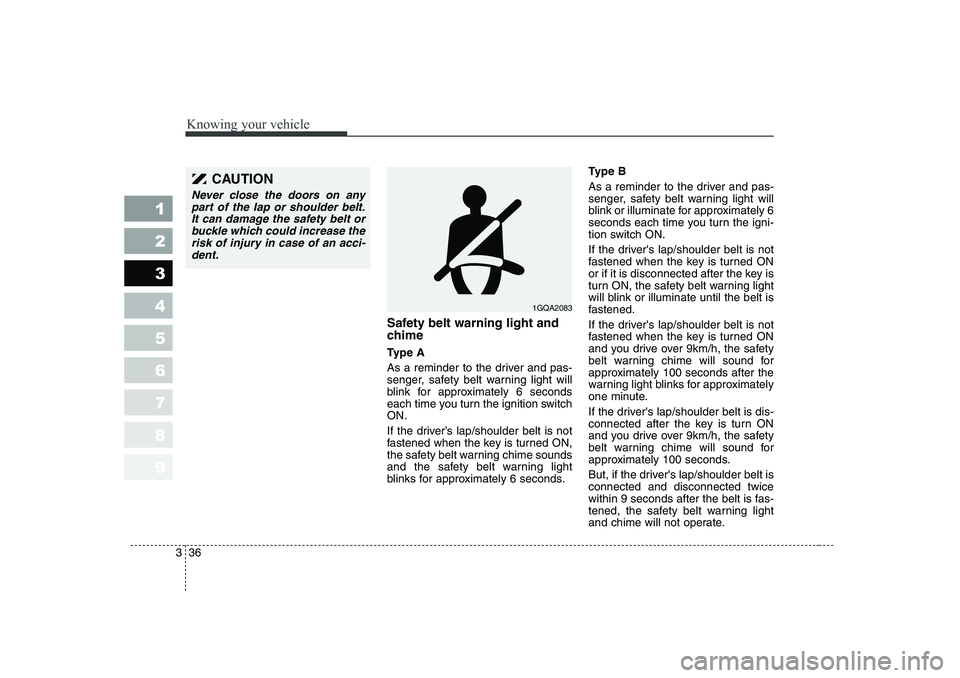
Knowing your vehicle
36
3
1 23456789
Safety belt warning light and
chime
Type A
As a reminder to the driver and pas-
senger, safety belt warning light will
blink for approximately 6 seconds
each time you turn the ignition switchON.
If the driver’s lap/shoulder belt is not
fastened when the key is turned ON,
the safety belt warning chime sounds
and the safety belt warning light
blinks for approximately 6 seconds. Type B
As a reminder to the driver and pas-
senger, safety belt warning light will
blink or illuminate for approximately 6
seconds each time you turn the igni-
tion switch ON.
If the driver's lap/shoulder belt is not
fastened when the key is turned ON
or if it is disconnected after the key is
turn ON, the safety belt warning light
will blink or illuminate until the belt is
fastened.
If the driver's lap/shoulder belt is not
fastened when the key is turned ON
and you drive over 9km/h, the safety
belt warning chime will sound for
approximately 100 seconds after the
warning light blinks for approximately
one minute.
If the driver's lap/shoulder belt is dis-
connected after the key is turn ON
and you drive over 9km/h, the safety
belt warning chime will sound for
approximately 100 seconds.
But, if the driver's lap/shoulder belt is connected and disconnected twice
within 9 seconds after the belt is fas-
tened, the safety belt warning light
and chime will not operate.
1GQA2083
CAUTION
Never close the doors on any
part of the lap or shoulder belt. It can damage the safety belt orbuckle which could increase therisk of injury in case of an acci- dent.
Page 49 of 315
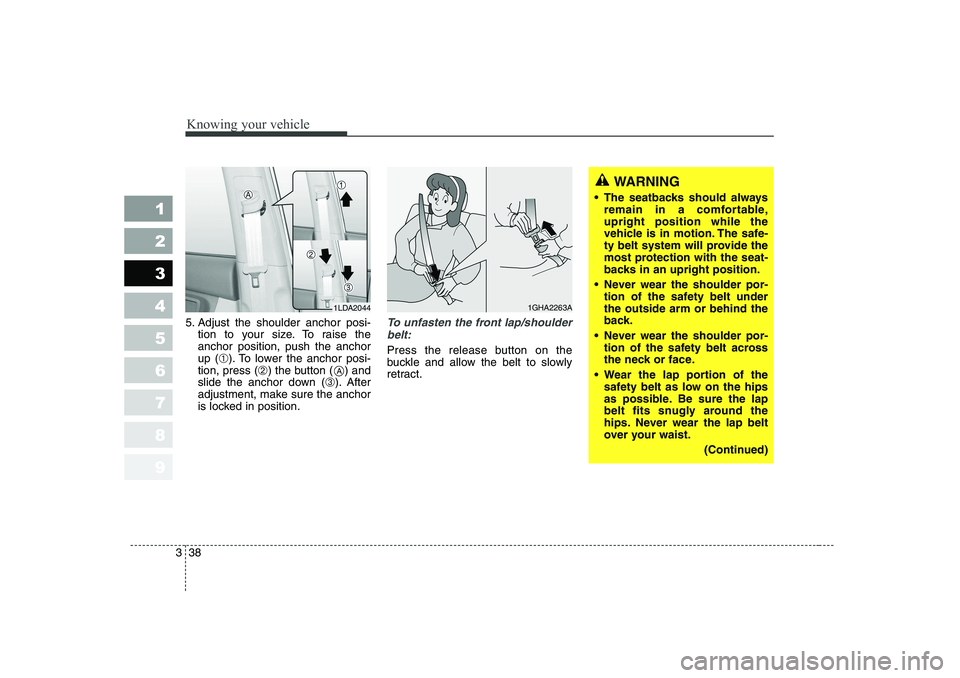
Knowing your vehicle
38
3
1 23456789
5. Adjust the shoulder anchor posi-
tion to your size. To raise the anchor position, push the anchorup ( ➀). To lower the anchor posi-
tion, press ( ➁) the button ( ) and
slide the anchor down ( ➂). After
adjustment, make sure the anchor
is locked in position.To unfasten the front lap/shoulder
belt:
Press the release button on the
buckle and allow the belt to slowly
retract.
1GHA2263A
WARNING
The seatbacks should always remain in a comfortable, upright position while the
vehicle is in motion. The safe-
ty belt system will provide the
most protection with the seat-
backs in an upright position.
Never wear the shoulder por- tion of the safety belt underthe outside arm or behind the
back.
Never wear the shoulder por- tion of the safety belt across
the neck or face.
Wear the lap portion of the safety belt as low on the hips
as possible. Be sure the lap
belt fits snugly around the
hips. Never wear the lap belt
over your waist.
(Continued)
1LDA2044
A
Page 50 of 315
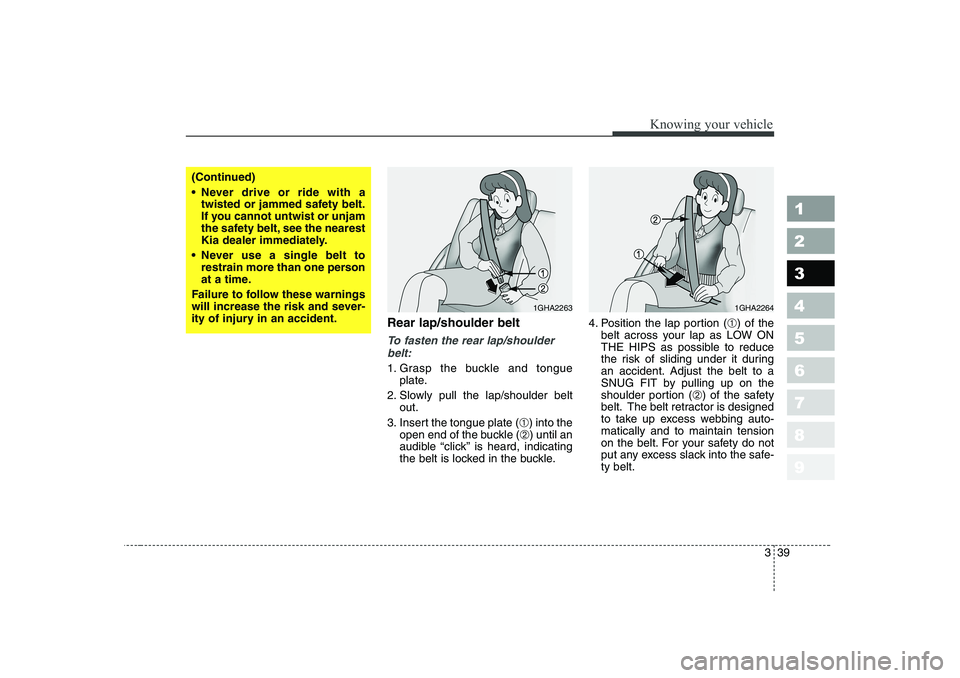
339
1 23456789
Knowing your vehicle
Rear lap/shoulder belt
To fasten the rear lap/shoulderbelt:
1. Grasp the buckle and tongue plate.
2. Slowly pull the lap/shoulder belt out.
3. Insert the tongue plate ( ➀) into the
open end of the buckle ( ➁) until an
audible “click’’ is heard, indicating
the belt is locked in the buckle. 4. Position the lap portion (
➀) of the
belt across your lap as LOW ON
THE HIPS as possible to reduce
the risk of sliding under it during
an accident. Adjust the belt to a
SNUG FIT by pulling up on the
shoulder portion ( ➁) of the safety
belt. The belt retractor is designed
to take up excess webbing auto-matically and to maintain tension
on the belt. For your safety do not
put any excess slack into the safe-ty belt.
1GHA22631GHA2264
(Continued)
Never drive or ride with a twisted or jammed safety belt.
If you cannot untwist or unjam
the safety belt, see the nearest
Kia dealer immediately.
Never use a single belt to restrain more than one person
at a time.
Failure to follow these warnings
will increase the risk and sever-
ity of injury in an accident.
Page 51 of 315
Knowing your vehicle
40
3
1 23456789
To unfasten:
Press the release button on the
buckle and allow the belt to slowly
retract.
Lap belt (if equipped)
To fasten the lap belt:
1. Grasp the tongue and pull it lowover the abdomen.
(Continued)
Never drive or ride with atwisted or jammed safety belt.
If you cannot untwist or unjam
the safety belt, see the nearest
Kia dealer immediately.
Never use a single belt to restrain more than one person
at a time.
Failure to follow these warnings
will increase the risk and sever-
ity of injury in an accident.
WARNING
Never wear the shoulder por- tion of the safety belt under the outside arm or behind the
back.
Never wear the shoulder por- tion of the safety belt across
the neck or face.
Wear the lap portion of the safety belt as low as possible.
Be sure the lap belt fits snug-
ly around the hips. Never wear
the lap belt over your waist.
(Continued)
1GHA2265
Lengthen
Page 53 of 315
Knowing your vehicle
42
3
1 23456789
To unfasten the lap belt:
Press the release button (
➀) on
buckle.
When using the rear center seat belt,
the buckle with the “CENTER” mark
must be used.
Stowing the rear seat belt (if equipped)
The rear seat belt buckles can be stowed in the pocket between the
rear seatback and cushion when
not in use.
The center seat belt can be stowed with the plate and webbing rolled in
the pocket between the rear seat-
back and cushion.
1LDN2045
1GHA2269
WARNING - Lap belt
Be sure the lap belt is posi-
tioned snugly around the hips,
and not on the waist. Failure to
position the lap belt snugly
around the hips will increase
the chance and severity of
injury in the event of a collision.
➀
2FDA2307
1LDN3026B
1LDA2046
Lap/shoulder belt type
Lap belt type
Lap/shoulder belt type
Lap belt type
Page 55 of 315
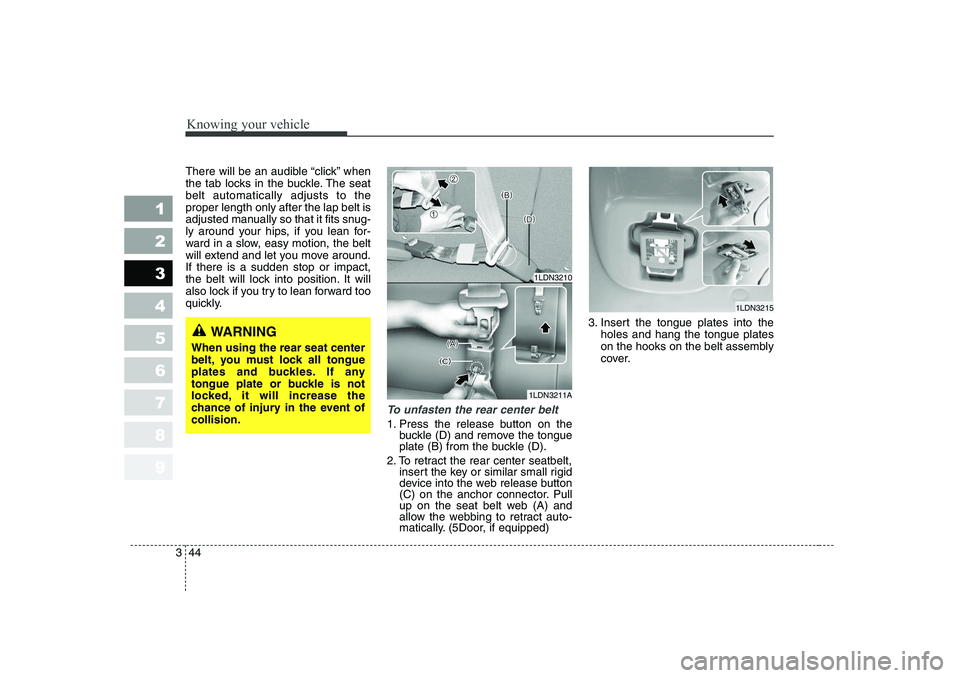
Knowing your vehicle
44
3
1 23456789
There will be an audible “click” when
the tab locks in the buckle. The seatbelt automatically adjusts to theproper length only after the lap belt is
adjusted manually so that it fits snug-
ly around your hips, if you lean for-
ward in a slow, easy motion, the belt
will extend and let you move around.If there is a sudden stop or impact,
the belt will lock into position. It will
also lock if you try to lean forward too
quickly.
To unfasten the rear center belt
1. Press the release button on the
buckle (D) and remove the tongue
plate (B) from the buckle (D).
2. To retract the rear center seatbelt, insert the key or similar small rigid
device into the web release button
(C) on the anchor connector. Pull
up on the seat belt web (A) and
allow the webbing to retract auto-
matically. (5Door, if equipped) 3. Insert the tongue plates into the
holes and hang the tongue plates
on the hooks on the belt assembly
cover.
WARNING
When using the rear seat center
belt, you must lock all tongue
plates and buckles. If any
tongue plate or buckle is not
locked, it will increase the
chance of injury in the event ofcollision.
1LDN3210
1LDN3211A
1LDN3215